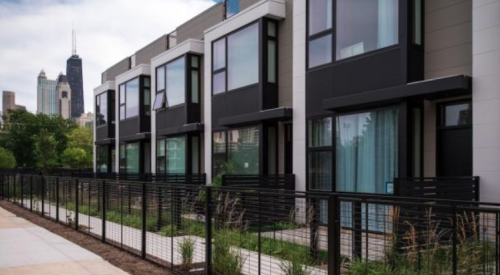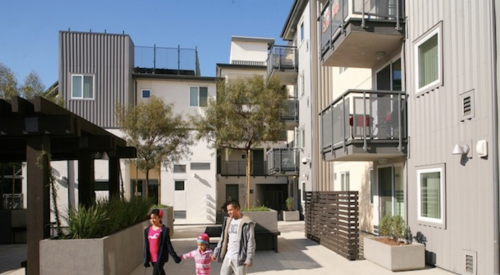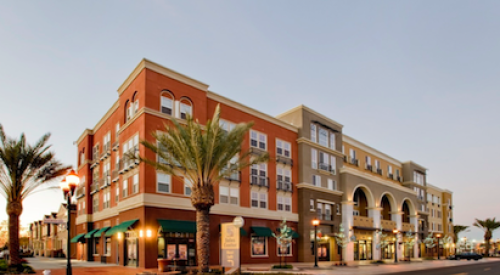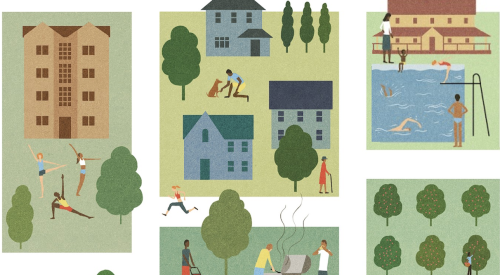| St. John’s Park is designed to complement the neighborhood, echo the Chicago vernacular and offer buyers outdoor amenities not usually found in city living, such as a large, open courtyard. |
It’s no surprise when a chic townhome development goes up in a terribly chic neighborhood. You know the place - where hair is done and linen donned just to walk the (pedigreed and groomed) dog. Where darling shops and designer coffeehouses identical to the ones in their old neighborhoods make residents feel at home. Building luxury there is easy.
But to build luxury homes in a decidedly not-so-chic neighborhood and keep from ticking off long-standing neighbors - that takes a leap of faith.
Rezmar Development founders Daniel Mahru and Antoin Rezko have a knack for finding, acquiring and transforming underused sites throughout Chicago. Rezmar started building affordable rental units on the South Side a decade ago and has quietly grown to be one of the largest new home developers in the city.
"We never acquire industrial property that is being utilized by viable companies," says Jennifer Arons, Rezmar’s vice president of sales and marketing. "We seek vacant property, rehab and renovate it, and put it back on the property tax rolls."
| More transitional than traditional in style, the lavish mantel treatment, built-ins and rich tones help the Asbury at St. John’s Park attract move-up buyers looking for sophisticated space. |
One of Rezmar’s latest projects, St. John’s Park (named after nearby, historic St. John Cantius Church), sits on a site recently occupied by an abandoned, one-story statuary factory in the emerging River West neighborhood, just across the Chicago River from the Loop. You’re as likely to find new construction there as you are light and heavy industry, established and aging housing, and weedy vacant lots. Surrounded by industrial buildings and adjacent to commuter rail tracks, the 3.2-acre, triangular site might have been passed over, but the developers knew it would work to their advantage, especially considering its proximity to downtown, an expressway and the el.
"We knew it would sell," Arons says. "The location is great, even though it is in a pioneering area. There aren’t any large townhome communities around there - a few single-family and a couple of six-unit townhomes - but there is not a lot going on in the area. We knew we could create a lifestyle - a pocket people would want to go to."
A Neighborhood in Transition
To achieve that lifestyle-oriented community, Rezmar turned to Pappageorge/Haymes Ltd., a Chicago architecture firm that had done work for Rezmar and understands its development style. The first order of business was to design an 82-unit development that would complement the existing community.
Describing the neighborhood as in transition, architect Jeff Renterghem explains that long-term residents in the area were wary of Rezmar’s development plans. "From day one, [St. John’s Park] was somewhat controversial because it’s the largest development in the neighborhood. There was concern from neighbors that it might take over the place." Partly in response to that concern, the eight buildings of St. John’s Park were designed to look like a "good neighborhood background building," Renterghem says. "It’s not screaming for attention."
Rather than the modern buildings seen in up-and-coming pockets of Chicago and other American cities, Pappageorge/Haymes and Rezmar went with something more in tune with the Chicago vernacular. Along with the trademark red brick is Victorian styling enunciated in the buildings’ details and proportions. Articulations in the cornices and masonry, along with a great deal of glass, accomplished through stacked windows and transoms, set the project apart from the usually plain speculative developments in most transitional and infill neighborhoods, Renterghem says.
The focal point of the community, and a top selling point for buyers, is the 12,300-square-foot, landscaped courtyard in the center of the lot. One end of the courtyard leads to the street on the west, and the east side is terminated by a unique, crescent-shaped building - an effect Pappageorge/Haymes uses often to terminate vistas, enclose courtyards and soften lines.
Other site issues included lessening the effects of major industrial properties and Metra commuter trains. "We had to design the units as well as the site so that views from the inside of the home didn’t get distracted by what was happening [beyond] the site," Renterghem says. To deaden the noise from passing trains, excellent sound attenuation was achieved by eliminating not only windows but all penetrations, including dryer and exhaust vents, on that side of the building. In addition, a high-tech wall assembly helped break down vibrations so that the trains are barely noticeable, Renterghem says.
Appealing to the Market
| With windows at only the front and back of the building, vertical stretches of glass maximize light and views in the Brittany model at St. John’s Park. |
As Arons suspected, buyers at St. John’s Park are mostly from the city. She calls St. John’s Park demographically mixed, with ages ranging from 25 to 85. Most buyers, she says, come to St. John’s Park because it’s so close to downtown and because they like living in an up-and-coming neighborhood - especially one that takes such pains to shield its inhabitants from its industrial setting.
It’s also one of the few new construction communities with so much outdoor space. Even with a density of 24 homes to the acre, each residence has a fenced-in front yard, a balcony and a rooftop deck, as well as use of the main courtyard. "There aren’t many obstructions to the south, so views from the roof decks are pretty spectacular," Renterghem says. "That becomes a real outdoor amenity in the city."
Rezmar knew that indoor amenities would be important, too. Hardwood floors, granite countertops, soaking tubs and cultured marble vanities are standard.
The interior spaces, ranging from 1,800 to 2,500 square feet, are sizable for urban townhomes, but Pappageorge/Haymes and Rezmar designed St. John’s Park for a buyer with a smallish space in mind. They expected many of their buyers to be loft dwellers looking for a more defined, sophisticated space. "From the very beginning, we set out to attract not only a townhome buyer but probably a second-home buyer - someone not necessarily looking for something big," Renterghem says.
"The trend in Chicago is toward bigger, four-story townhomes," he adds. Renterghem attributes this trend to several factors including the high price of land, which necessitates that developers achieve a higher return on investment " something easily done with larger square footages. Moreover, he says, zoning requirements on issues such as setbacks and private side yards, especially in the past three to four years, have meant fewer townhomes could be built on each plot of land in certain Chicago neighborhoods. "Ten years ago you could get 30 units to the acre," Renterghem says. "Now if you can get 20, you’re pretty happy."
Rezmar was different because it "bought right, and the timing was right," Renterghem says. The developer was better able to negotiate the planned development with the city because it was not in an area with a lot of good, existing residential stock, nor did it have strong neighborhood groups mounting tough opposition to new development.
| Rezmar’s contemporary Brittany model at St. John’s Park is decorated with a built-in wet bar, cool colors and hip furnishings to appeal to young city buyers. |
Still, the small size of the units presented challenges. With only an 18240-foot footprint, a program calling for two and three bedrooms, and windows at just the front and back, the units were a challenge to design. "You have to get a lot of space in a small box yet try to maintain the critical components of the architecture," Renterghem says. "The quickest way to a sense of space is by increasing the ceiling height and increasing the windows." Ceiling heights are 10 feet, and transoms stacked on large windows and patio doors resemble walls of light. Continuous wood flooring throughout maintains a good flow, and an open floor plan allows for vistas from front to back. Still, Renterghem says, units at St. John’s Park have formal spaces rather than one main, multifunction room.
St. John’s Park is one of the relatively few new home communities in Chicago with on-site models. Arons says one of the main reasons behind building the two models, which opened in January 2000, was to give buyers a sense of what to expect, perhaps despite the heavily industrial neighborhood. "You maximize product by being able to touch and feel to get a sense of the quality," she explains.
The models are decked out to appeal to two kinds of buyers. The Brittany has a more contemporary look, says Joanne Siciliano, senior interior designer with Riha Design Group. "It’s for first-time buyers, definitely city people, furnished hip and trendy for a couple living just west of downtown."
The Asbury is more sophisticated to target move-up buyers in their late 30s, 40s or 50s. "[The Asbury] is not traditional but transitional," Siciliano says. "With three bedrooms upstairs, it’s geared to a couple with a child maybe 10 to 13 years old. Then the third bedroom is done like a den or office, with open walls at the top of the stairs, a desk, two comfy chairs and an ottoman."
The effect worked: With 30 pre-construction sales, the community sold out in 18 months, with only the two models left to sell. Prices rose more than anticipated as well, with a typical Brittany unit moving from a starting price of $349,900 to $399,900 at close-out.
"It was once an industrial site, and taking it from industrial to residential [marks] a radical change in neighborhood," Renterghem says. "It required a great leap of faith from buyers. But certainly St. John’s Park will have defined this neighborhood and stabilized it."












